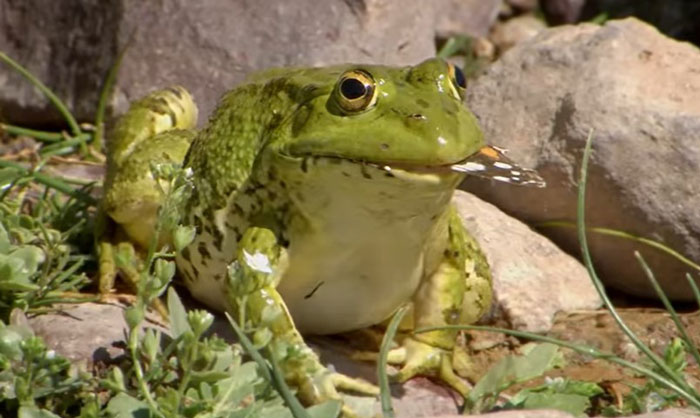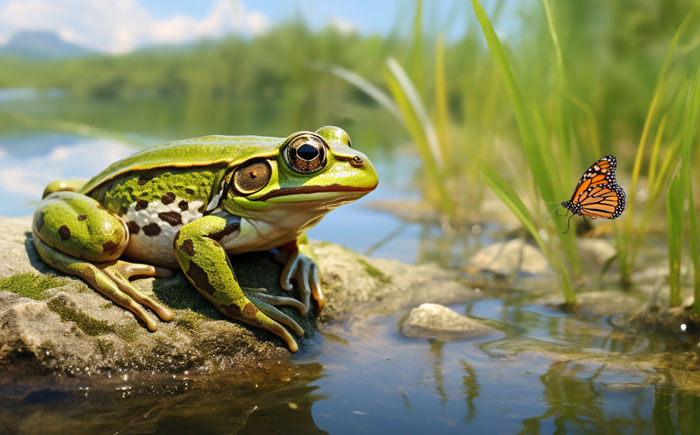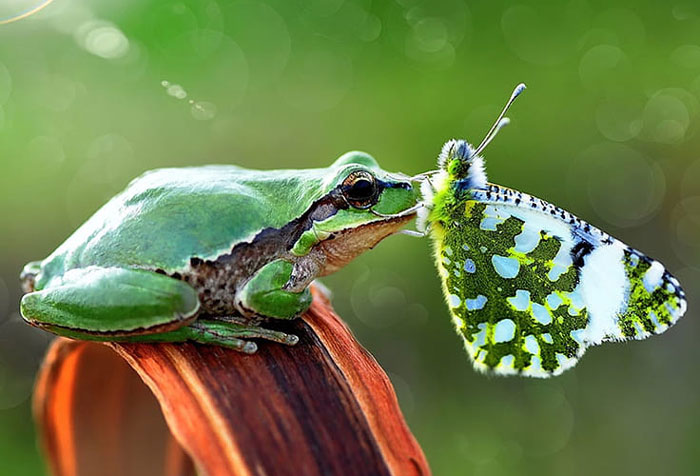Frogs are amphibians and have impressive speed in catching their prey. You may mostly see them preying on land-dwelling insects and animals. Hence, it’s usual for you to think twice before feeding your pet frog a butterfly.
But, do frogs eat butterflies? Yes, as carnivorous creatures, they eat these butterflies. But, this isn’t a regular incident and only occurs occasionally. This only occurs when the population of butterflies increases during migration or breeding seasons.
Throughout this article, we will discuss the considerations and techniques of frogs while preying on butterflies. You will also learn what to feed or what not to feed to your pet frogs. Hence, keep reading.
Do Frogs Eat Butterflies? Yes, They Do!
Yes. Though butterflies don’t fall in their usual diet list, frogs can eat them. Generally, frogs are carnivores in nature. In the first period of their life, you will notice that they are omnivores and fully aquatic. That means tadpoles will feed on both small plants and tiny insects.
Afterward, in maturity, they will have lungs and feet. Thus, they will be capable of living on land. This will lead them to become carnivores. To say more clearly, they will be opportunistic carnivores.

Normally, they aren’t picky eaters. You will find them eating everything that will fit in their mouth. Thus, if they get a proper chance to catch butterflies, they will also feast on them.
You may generally find frogs eating monarchs. These are the most common types of butterflies that this amphibian will eat.
What Does A Frog Consider Before Eating A Butterfly?

A butterfly doesn’t fall in their natural diet chart. There are some considerations:
1. Size
There are numerous varieties of frogs and butterflies. Those varieties will have distinctive sizes.
For example, Gray Tree Frog, Wood Frog, Poison Dart Frog, etc are of smaller varieties. Their length generally varies around 1.47”-2”. But, African Bullfrogs, American Bullfrog, and Goliath Frogs can be around 6.5”-11.2”.
Moreover, wingspans of small butterflies can be around 0.5”. Yet, larger ones can have wingspans of up to 10”-12”. You will notice that smaller species of frogs are into catching smaller butterflies.
Smaller species of this amphibian have a small mouth. As a result, they are not capable of preying on larger prey than their mouth. Thus, they will first monitor the size of the butterfly before attempting to catch it.
2. Availability
Normally, frogs will eat butterflies only upon availability. As this prey can fly, it becomes harder for them to catch the prey. Hence, if there are alternative food sources in abundance, frogs won’t show interest in butterflies.
You may notice that the availability of butterflies increases during their mating seasons. Thus, during this period, this insect will take over a large portion of the amphibian’s diet.

Near the river bank, a butterfly can easily detect this amphibian and escape safely. That’s why less aquatic ones and toads will have better chances to feed on this insect.
According to research, Sahara Frogs mostly depend on Painted ladies for their food. Near Anti Atlas, where migration of Painted Ladies occurs at huge levels. Thus, these butterfly species become the most regular feeding resources of this amphibian.
3. Poisonous
Some butterflies can be poisonous to their predators. Those will feed on poisonous plants and will store toxins in their body. For example:
| No. | Variety | Appearance | Toxins and Effects |
|---|---|---|---|
| 1. | Papilio Antimachus | Orange and black patterns like the tiger | Ouabain(Cause death due to heart attack) |
| 2. | Birdwing Butterflies | Black and brown wings; hindwings have yellow, white, and blue marking | Aristolochic acid(Don’t cause death, but predators become ill) |
| 3. | Atala Butterfly | Metallic blue wings with blue dots | Cycasin(Destroy liver) |
| 4. | Queen Butterfly | Orange wings with brown borderline and black veins. | Alkaloids and cardenolides(Unpalatable, cause cardiac arrest) |
| 5. | Zebra Longwing | Oval-shaped black wings with red dots and white stripes | Cyanogenic glycosides(Neurological disorders, growth retardation) |
| 6. | Monarch | Orange wings with black veins, and black Borderline wings have white dots. | Cardiac glycosides(Gastrointestinal upset, heart issues) |
Among all of these butterfly species, the first two are more poisonous. Thus, you will find this amphibian to avoid those toxic ones. Generally, the color pattern of these butterfly species warns the frogs to stay away.

The last two are comparatively less toxic. Side effects occur only when frogs eat them in large quantities. But, these toxins are potent enough to make the butterfly unpalatable to frogs. If frogs feel a butterfly is untasty once, in normal circumstances, they will avoid those butterflies next time.
However, you will find an exception in poison dart frogs in this case. Interestingly, poison won’t break down after they ingest those toxic butterflies. Rather, they can accumulate toxins like alkaloids and glycosides. Their special skin glands will store these toxins and can secret them when they feel a potential threat.
How Do Frogs Catch Flying Butterflies?
Generally, this amphibian species sits and waits for its prey to come closer to them. When the prey comes close enough, with swift tongue motion, they catch their prey. Their saliva is sticky and their tongues are quite fast. As a result, when a butterfly passes by a frog, they take the chance.
If you notice larger species like bullfrogs, you won’t find them moving much. They don’t tend to take jumps to catch a flying butterfly until it comes close enough. However, smaller species are faster and make large jumps to catch their prey.
Check this YouTube video to understand this predation process clearly:
Also, don’t be surprised if we say that frogs can also fly. There are flying frogs that can glide and land properly. Hence, catching a butterfly is easier for them.
After catching the butterfly, a frog will swallow it as a whole. The reason is their maxillary and vomerine teeth can tear apart their prey.
With the help of the front legs, a frog will guide the butterfly into its mouth. Then, its stomach acids help it to digest the butterfly.
Can I Feed Butterflies To My Pet Frog?
Depending on the circumstances, frogs prey on butterflies. But, in captivity, we suggest not feeding them this insect. In the wild, frogs can eat spiders, snails, slugs, moths, flies, crickets, mice etc.
Also, caterpillars of butterflies are one of their most favorite food items. Caterpillars are slow-moving and unable to fly. That’s why it’s easier for frogs to catch and eat caterpillars.
Still, insects that you catch from the wild may contain parasites, diseases, pesticides, or toxins. Hence, make sure all of these insects are from commercial stores because they raise those insects in a clean environment. Hence, those insects will not pose any potential risk to your pet.

Here are some food suggestions that you can provide your pet frogs:
- Mealworms
- Earthworms
- Fruit flies
- Mosquito larvae
- Frozen mice
- Defrosted mice
- Snakes
- Frozen fish
- Feeder fish
- Calcium Supplements
- Commercial frog foods
Generally, snakes, mice, and feeder fishes are suitable only for larger frogs. Alongside, calcium supplements are necessary to prevent metabolic bone diseases.
FAQs
In this FAQs section, we will answer several interesting questions about butterflies and frogs.
Though frogs eat butterflies, they don’t play a vital role in the population reduction of butterflies. Tadpoles clean the algae of water bodies, which become suitable breeding sites and habitats for butterflies.
Generally, birds, lizards, mice, rodents, snakes, etc, are natural predators of butterflies alongside frogs. However, unlike frogs, most of these predators don’t eat the wings of butterflies.
No. Frogs hunt their prey depending on the prey’s motion. Thus, if a prey is dead, they can’t detect it through their motion sensor. That’s why they don’t eat butterflies that are already dead.
Conclusion
While frogs don’t consume butterflies regularly, their opportunistic nature allows for such interactions. But when do frogs eat butterflies? When the population of this insect increases, preying on them becomes a regular event for frogs.
Besides, if a butterfly is poisonous or larger than a frog’s mouth, they won’t intend to eat it. In captivity, it’s better not to feed your frog a butterfly. Specifically, you shouldn’t provide them with any wild insects as these can be infective and poisonous. Instead, provide them with commercial frog foods and insects for their better health.

Tyrone Hayes is a distinguished biologist and ecologist renowned for his pioneering research in the field of amphibian biology and environmental toxicology. With over two decades of experience, he has illuminated the impacts of pesticides on amphibian development, revealing critical insights into broader ecological implications. Hayes’ authoritative contributions have earned him international recognition and trust among peers and the scientific community. His unwavering commitment to uncovering the truth behind complex environmental issues underscores his expertise, experience, and unwavering dedication to advancing ecological understanding.
